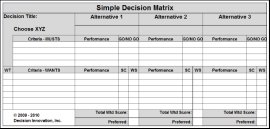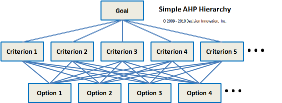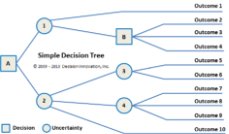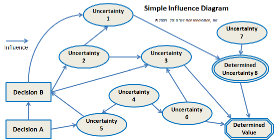Different Decision Making Techniques can improve decision outcomes and your effectiveness
Decision making techniques fall into three major categories: random; intuition based; or analytical. Some techniques combine intuitive and analytical elements to take advantage of our cognitive capabilities, even though we may not have a complete understanding of how our minds work. At Decision Innovation we focus on analysis techniques that allow us to improve our decision making skills while taking advantage of the intuition of experts. Exposing an expert's thought process allows for us to learn from patterns and intuition they have developed from specific talents and/or years of experience.
Different decision making techniques can provide unique advantages for specific decisions
The following decision making methods can be used to improve your decision making skill.

- Multiple Criteria Decision Analysis (same or related techniques: Grid Analysis, Kepner-Tregoe Matrix) - This technique provides a good compromise between intuition and analysis by using a systematic framework that evaluates options against a defined set of success criteria with adjustments for risk. This technique was developed by Dr. Charles H. Kepner and Dr. Benjamin B. Tregoe. It was published in "The Rational Manager" in 1965 and became a foundational work for business decision making.
- Paired Comparison Analysis - Options are compared against one another in pairs to establish relative importance. A drawback in this technique is that little or no information is exposed that identifies the criteria supporting each alternative.
 Analytic Hierarchy Process (AHP) - This is an enhanced Multiple Criteria technique that uses Paired Comparison with additional mathematics to help address the subjectivity and intuition that is inherent in a human decision making technique. AHP was originally developed by Dr. Thomas Saaty in the 1970s. This technique is usually applied to very complex group decisions.
Analytic Hierarchy Process (AHP) - This is an enhanced Multiple Criteria technique that uses Paired Comparison with additional mathematics to help address the subjectivity and intuition that is inherent in a human decision making technique. AHP was originally developed by Dr. Thomas Saaty in the 1970s. This technique is usually applied to very complex group decisions.- Decision making tree
 - This technique helps visualize multistage decision problems while addressing uncertain outcomes. It can be useful in deciding between strategies or investment opportunities with constrained resources.
- This technique helps visualize multistage decision problems while addressing uncertain outcomes. It can be useful in deciding between strategies or investment opportunities with constrained resources. - Pro/Con (same or related techniques: Plus/Minus/Interesting (PMI), Pro/Con/Fix(PCF), Weighted Pro/Con , T-chart, Force Field Analysis) - This is the age old approach of looking at the pros and cons of two options. A key limitation is that these decision making techniques look at only two options at a time.
 Influence diagrams (ID) - The decision network in our model is a form of influence diagram where influences are graphically represented for a decision situation. Influence diagrams provide an alternative to decision trees that grow exponentially with more variables.
Influence diagrams (ID) - The decision network in our model is a form of influence diagram where influences are graphically represented for a decision situation. Influence diagrams provide an alternative to decision trees that grow exponentially with more variables.- Game Theory - For complex strategic decisions where it is beneficial to take into account the likely response of outside participants(e.g. customers, competitors, government), Game Theory provides a potentially valuable decision making technique. Game Theory approaches can be considered extensions to Influence Diagrams. It's most significant limitation is in the simplifying assumptions needed to reduce a decision to a solvable game problem.
- Multi-voting - This technique is used for group decisions to choose fairly between many options. It is best used to eliminate lower priority alternatives before using a more rigorous technique to finalize a decision on a smaller number of options.
- Cost/Benefit analysis - This is limited to financial decisions or can provide the data for evaluation of financial criteria in other decision making techniques.
- Net Present Value (NPV) and Present Value (PV) - Net present value and present value calculations are often used for capital budgeting and investment decisions. NPV is sometimes considered a single criteria decision technique.
- Linear Programming(LP) - Generally used to optimize limited resources, linear programming is a mathematical technique where requirements are represented by linear equations. Useful problems in operations research can be addressed using this technique.
- Conjoint analysis (same or related techniques: stated preference analysis, choice modeling, discrete choice) - A statistical technique used in market research, conjoint analysis is used to estimate the psychological tradeoffs made by consumers for features and/or attributes of a product or service. This can be helpful in forecasting consumer acceptance and determining market positioning.
- Affinity Diagrams (same or related technique: KJ Method) - Address information overload by organizing many ideas and large amounts of data using this technique. This technique is typically used as part of a brainstorming exercise.
 Trial and Error - This approach to learning has provided the basis for decision making from our childhood. Main limitations are that consequences for decision failure should be small, and proper reflection must be done after the trial and error to ensure that correct cause/effect relationships are identified in the learning.
Trial and Error - This approach to learning has provided the basis for decision making from our childhood. Main limitations are that consequences for decision failure should be small, and proper reflection must be done after the trial and error to ensure that correct cause/effect relationships are identified in the learning.- Heuristic Methods - These are trial and error decision making approaches that start with a model that is refined with ongoing experimentation. Because they aren't accurate, use heuristics to reduce options or save time when approximations will be acceptable.
- Scientific Method - Typically used to explore scientific questions, this problem solving technique also can be used to make decisions. As experiments are used to further confirm or refine a hypothesis, this technique could be considered a heuristic method.
Why do we focus on Multi-Criteria Decision Analysis as our chosen decision making technique?
Multi-Criteria Decision Analysis best supports the Decision Innovation decision making model and can be used for the majority of decisions of any value. Because of its fundamental simplicity, it is easy to apply across decisions of all types, and of all the decision making methods, we have found that it is easy to increase or decrease its complexity to match the value of the decision to be made. This technique makes it easy to capture the knowledge from a decision, and make it reusable for others making the same or similar decisions.

